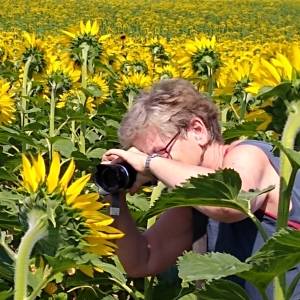Private view
Warning: long post!
It was 35C this afternoon; S had gone to lunch with his walking club to celebrate their 25th anniversary, and I had decided to go to the cinema to see The Eagle Huntress, a documentary released last year that I remembered several blippers (including Connections and WalkingMarj) being very enthusiastic about.
This is the scene that met me as I entered the cinema minutes before the film was due to start. I settled in, no-one else arrived, and the projectionist showed it just for me. It's a beautiful film, with a lovely narrative about a 13-year old girl in the mountains of Mongolia who is the first ever to engage in the traditional male activity of hunting using a trained golden eagle. The scenery is fabulous and beautifully filmed, there are dazzling action sequences, notably of young Aisholpan capturing a fledgling eagle from its nest on a vertiginous rockface, and later an eagle-hunting competition where she shines as the only female competitor. The film ends with magnificent footage of Aisholpan and her father hunting a fox in the snow. A wonderfully motivational film for teenage girls, and indeed boys.
When I left it was still 35C, the glaring sunlight bouncing off the pavements. I drove home and settled gratefully into our cool, dark living room. I looked up the film on IMDb and then started wondering about some things. Director Otto Bell follows Aisholpan from her first steps with an eagle to her triumph as a hunter. How did he find her, and how did he know that she was going to become a successful huntress? Some parts of the film were clearly staged or resequenced to make a good narrative.
::Google interlude::
Well, Aisholpan had originally been found by an Israeli photographer, who published photographs of her, describing her as the only female eagle hunter in Mongolia. Bell, who made documentary films for an advertising agency, saw the photos and was fascinated enough to go to Mongolia and sign the family up for a documentary.
But a documentary about the traditional nomadic lifestyle in Mongolia was hardly going to pull them in at the box office. An appealing narrative had to be that Aisholpan had overcome centuries of patriarchal prejudice in order to engage in a traditionally male activity, beating the men at their own game.
Except ... that this is a completely false narrative. One of the earliest hits in my Google search was a fascinating paper by Stanford academic Adrienne Mayor, The Eagle Huntress: Ancient Traditions and New Generations (PDF). In it, she easily demonstrates that a tradition of women hunting has existed in this part of the world for millennia, with the Amazons of Greek mythology being an early example. Aisholpan is brave and very talented; she's the first woman in her family to hunt with eagles, but she's definitely not the only contemporary huntress; Mayor found several others, including one who combines the activity with being a lawyer, and even an American falconer, Lauren McGough, who spent time in Kazakhstan in 2009 being taught to hunt by the nomads. It's a really interesting article; I highly recommend reading it.
In fact, the real story is that nomadic societies, unlike hunter-gatherer ones, appear to be remarkably egalitarian, with men and women sharing daily tasks, including hunting, eagle training, and care of livestock. Aisholpan's father isn't an outlier in his willingness to teach his teenage daughter a "man's job", and allow her to undertake dangerous activities such as abseiling down cliffs to rob an eagle's nest; he seems fairly typical. While watching the film, I had wondered why, after the build-up of "prejudiced men try to stop girl doing what she wants", the actual objections seemed quite mild. Even at the national hunting competition, the judges and other competitors seemed only mildly surprised, and did not laugh or try to stop her competing. No-one ever said to her face that she shouldn't do it, and her father is fully supportive (the bond between them is lovely to see). So in the end, while Aisholpan is a worthy and inspiring heroine, the whole premise of the film is designed to pander to Western preconceptions about "backward societies".
A somewhat sourer taste of exploitation is left by this Medium article by Jamie Stantonian: "the rich traditions of Kazakh eagle hunting are being distorted and Disneyfied" ... including a lifetime rights contract worth one US dollar, written in English and signed by Aisholpan's father with no witnesses other than production company staff (although I believe Otto Bell did pay the family more later).
And all that from a few minutes with Google; isn't the Internet wonderful? I would still urge you to see this film if you get the chance, preferably taking a teenage girl with you; despite the missed opportunity to explore the realities of nomad life, it is beautifully filmed.

Comments
Sign in or get an account to comment.


